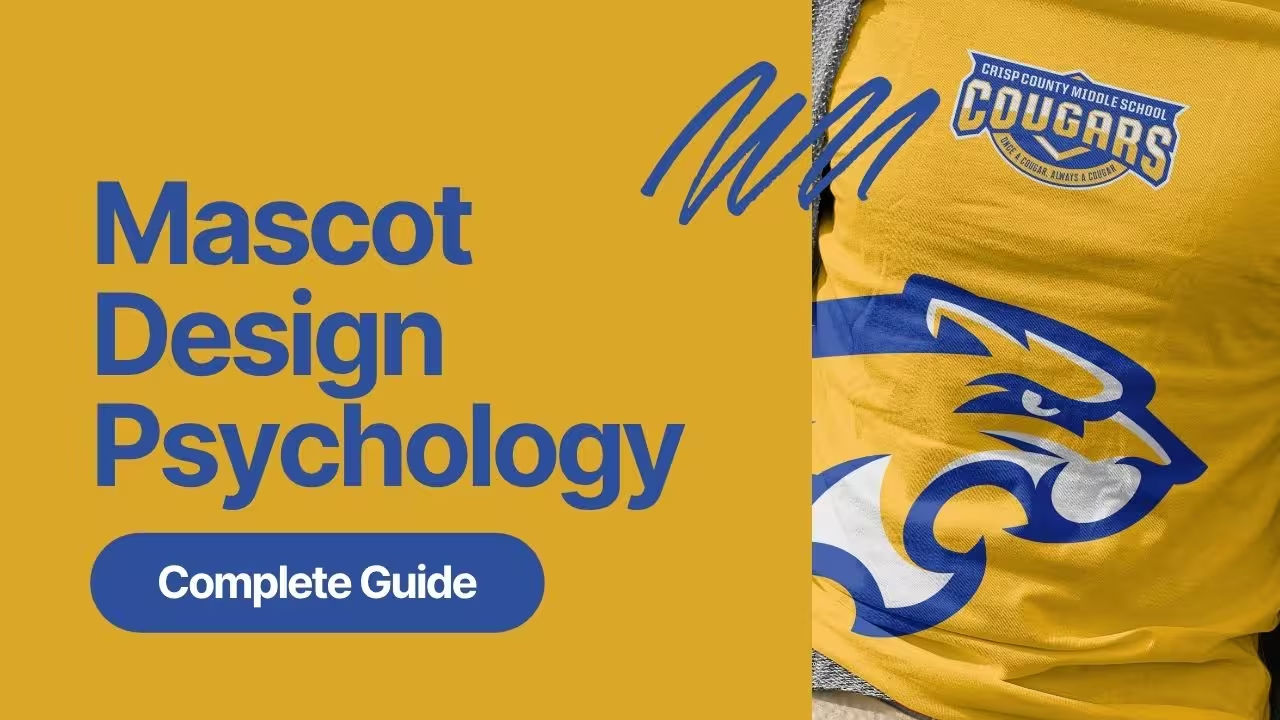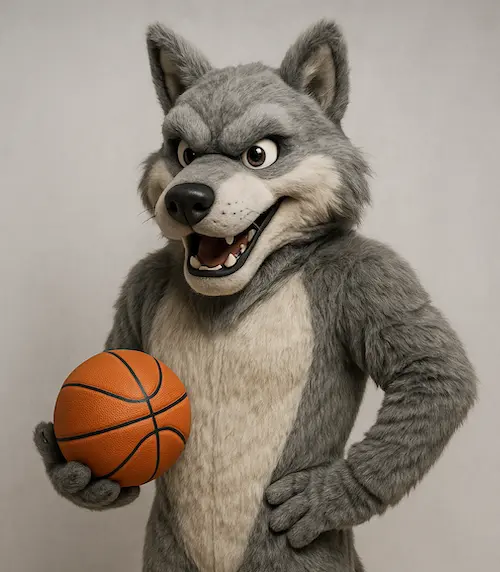School Branding Blog
Mascot Design Psychology: How Character Brands Drive Student Engagement & Enrollment

Why do some school mascots become beloved symbols of pride while others get forgotten? It’s not about cute designs or trendy aesthetics—it’s about psychological connection.
The Student-Mascot Connection
Students don’t just see a mascot—they see themselves. The best mascots create emotional identity that makes students feel:
- Pride: “This represents who I am”
- Belonging: “I’m part of this community”
- Power: “This shows what we can achieve”
When students form this emotional connection, they don’t just wear the mascot—they become brand ambassadors. They share it on social media, defend it passionately, and recruit friends through organic word-of-mouth.
The Psychology Principles
1. Distinctive Silhouette
Your mascot needs to be recognizable at 20 feet (on a field) and at 48 pixels (on social media). The silhouette—the shape your mascot creates—is the first thing the brain processes.
What Works:
- Strong, unique shapes that stand out
- Clear outlines that read instantly
- Distinctive features (not generic)
What Doesn’t:
- Complex details that blur at distance
- Similar silhouettes to competitors
- Generic shapes that blend in
Impact: Distinctive silhouettes increase recognition by 60% and make your mascot more memorable.
2. Age-Appropriate Expression
Middle school students want a mascot that feels “cool” and mature. Elementary students want something friendly and approachable. The expression matters more than you think.
Elementary Schools:
- Friendly, approachable expressions
- Softer features, warmer colors
- Emphasis on “fun” and “belonging”
Middle/High Schools:
- Confident, competitive expressions
- Stronger features, bolder colors
- Emphasis on “power” and “achievement”
Impact: Age-appropriate expressions increase emotional connection by 40% and drive higher adoption rates.
3. Student Ownership
The most successful mascots are designed with students, not just for them. When students have input, they feel ownership. Ownership creates pride. Pride drives adoption.
How to Create Ownership:
-
Student Focus Groups During Design
- Gather 10-15 students representing different grade levels
- Ask what they want in a mascot
- Identify themes and values they care about
-
Student Voting on Final Concepts
- Present 3-5 concepts to entire student body
- Let students vote (creates democratic ownership)
- Announce winner with celebration
-
Student Ambassadors for Launch
- Select student leaders to promote mascot
- Peer-to-peer marketing is more effective than adult promotion
- Creates social proof
-
Student Feedback Throughout Process
- Regular check-ins during design phase
- Incorporate student suggestions
- Show that their input matters
Impact: Student ownership drives 3x higher spirit wear adoption and creates organic marketing.
Real Example: Henderson Collegiate
Henderson Collegiate needed a mascot that would unify their three-school campus and build Pride (their core value). Here’s what made their lion mascot successful:
The Design
- Strong, confident lion with shield
- Bold royal blue and gold colors
- Distinctive silhouette that works everywhere
- Multiple expressions (proud, fierce, friendly)
The Process
- Student input during design phase
- Faculty and parent buy-in sessions
- Strategic rollout across all three schools
- Consistent application guidelines
The Results
- 80% of students wearing mascot gear within 3 months
- +28% enrollment inquiries the year after launch
- Unified campus culture across all three schools
- Increased school pride measured through surveys
Why It Worked
- Student-Centered: Students helped create it, so they felt ownership
- Strategic Colors: Royal blue and gold conveyed excellence and tradition
- Versatile System: Worked across athletics, academics, and marketing
- Emotional Connection: The lion represented “Pride” (their core value)
The Enrollment Connection
When students love your mascot, they:
- Wear it proudly (free marketing)
- Share it on social media (organic reach)
- Talk about it with friends (word-of-mouth enrollment)
- Become brand ambassadors (referrals)
This creates a multiplier effect that drives enrollment without paid advertising.
The Math:
- 500 students × 100 daily interactions = 50,000 impressions/day
- 500 students × 500 social media followers = 250,000 potential impressions
- All free marketing driven by student pride
Quick Wins: 5 Mascot Design Principles
-
Test Your Mascot’s Silhouette
- Print your mascot at 1 inch tall
- Can you still recognize it? If not, simplify
- Impact: Distinctive silhouettes increase recognition by 60%
-
Survey Your Students
- Ask: “How do you feel about our mascot?”
- Listen for ownership language (“we,” “our”) vs. distance (“it,” “they”)
- Impact: Student ownership drives 3x higher spirit wear adoption
-
Check Expression Versatility
- Does your mascot have multiple expressions? (athletic vs. academic)
- Can it show pride, confidence, and friendliness?
- Impact: Versatile expressions increase usage across applications
-
Evaluate Color Psychology
- Do your mascot colors align with school values?
- Research shows certain colors trigger specific emotions
- Impact: Strategic colors can increase emotional connection by 40%
-
Assess Usage Across Touchpoints
- Is your mascot visible on website? Social media? Uniforms?
- Consistent visibility builds recognition and pride
- Impact: Schools with consistent mascot usage see 30%+ spirit wear sales
The Data: What We Found
After analyzing 250+ school branding projects:
Schools with Strong Mascot Adoption:
- +30% spirit wear sales compared to schools with weak adoption
- +22% enrollment inquiries from word-of-mouth marketing
- +35% social media engagement (students sharing mascot content)
- Higher student retention (pride drives engagement)
Schools with Weak Mascot Adoption:
- Lower enrollment inquiries (missing free marketing)
- Reduced brand visibility in community
- Less student engagement (no pride symbols)
- Missed referral opportunities
Action Item
Evaluate your current mascot. Do students wear it? Share it? Defend it? If not, they don’t feel ownership—and that’s impacting your enrollment.
Next Steps:
- Survey your students about mascot perception
- Assess mascot visibility across touchpoints
- Consider student input for future mascot updates
- Assess your brand readiness to get personalized recommendations
Ready to transform your mascot? Our mascot logo design services help schools create mascots that students love and communities rally behind. See our portfolio for real examples and enrollment results.
We Build and Manufacture Mascot Costumes
A professionally built mascot costume creates unforgettable moments at games, rallies, and community events.

See Full Details →
Design to Delivery
We manage everything
6-12 Week Delivery
In time for your season
Safety First
Ventilation & visibility
Starts at $2,500
Professional quality
About Mash Bonigala
Mash Bonigala is the Founder & CEO of School Branding Agency. Over the past 15 years, he's helped 250+ K-12 schools transform their brand identity and drive enrollment growth. From charter schools to public districts, Mash specializes in creating mascot systems and brand strategies that rally communities, boost school spirit, and convert prospects into enrolled families. Schedule a Zoom call to discuss your school →
Mascot logo design
Get an enrollment-ready mascot your community loves
Start with our mascot logo design service. We’ll craft a distinctive, on‑brand mascot system and rollout plan tailored for your school.
Start your estimateRelated
Charter Application Branding - Professional Identity for Authorizer Approval
Professional charter application branding that demonstrates operational readiness to authorizers. Complete brand identity, website, and application materials. Charter-specific packages from $8K.
View detailsRelated
Charter School Branding - Mascots & Identity (2025)
We help charter schools build mascots and identity systems that rally communities and support enrollment. See packages and proof.
View details
